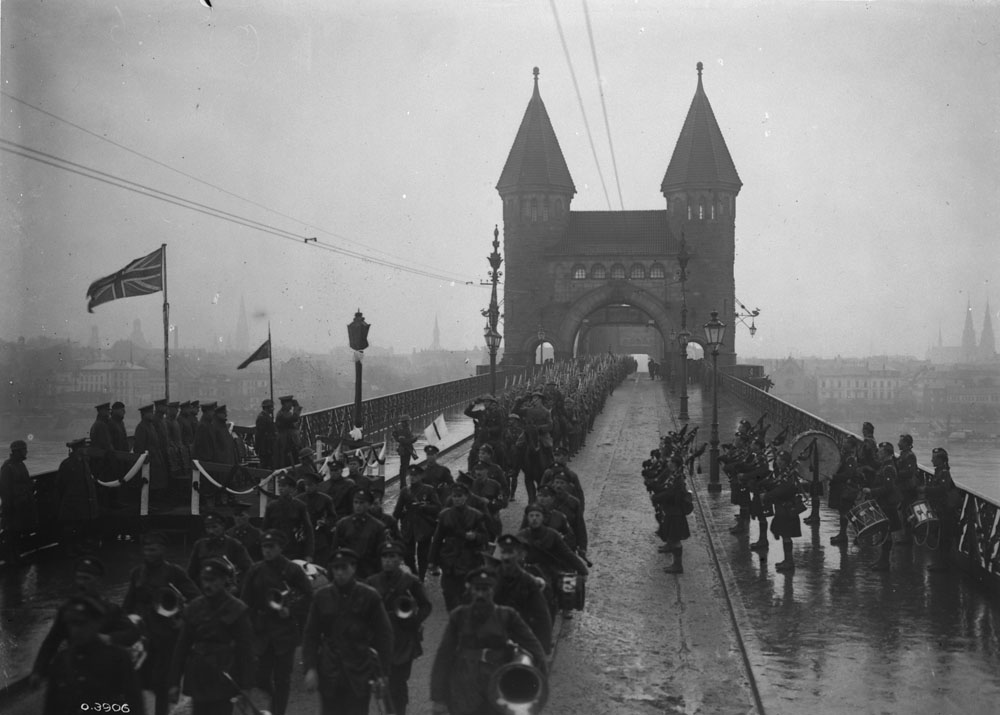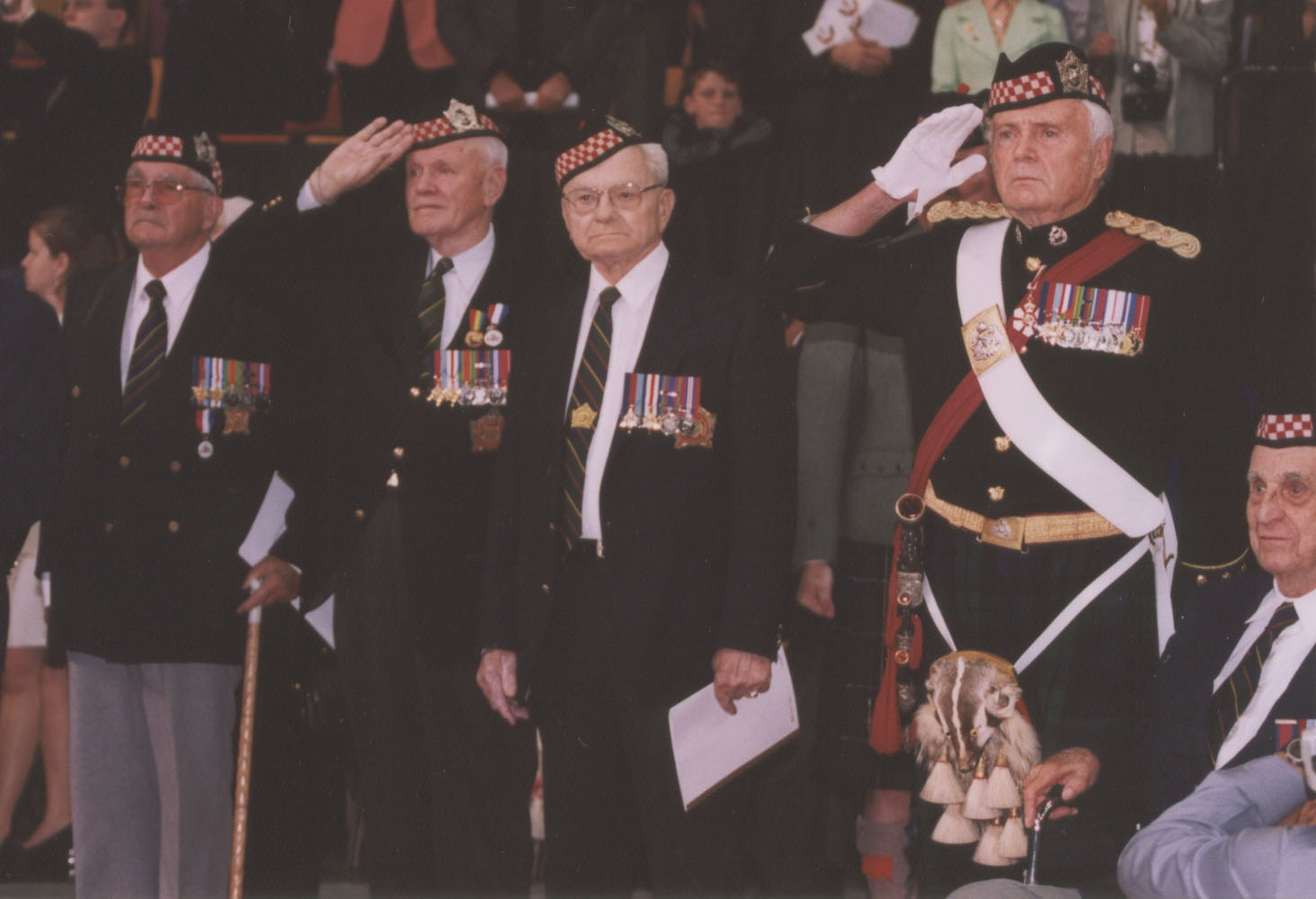Argyll Regimental Foundation
Purpose of the Foundation
The Argyll Regimental Foundation (ARF) was established in the early 1980s in response to the challenge of perpetuating the distinctive Highland dress that symbolizes the Regiment and its service. The cost of maintaining this dress is borne by the Regiment, as it has been since 1903, with modest support from the federal government.

This was the dress worn by the Pipes and Drums of the Argylls’ 19th Battalion CEF as they played the victorious Canadian Corps across the Rhine River in 1918 (see image above), and it was the dress worn by the Pipes and Drums of the 1st Battalion The Argyll and Sutherland Highlanders of Canada as they led the Canadian contingent in the British victory parade in Berlin in July 1945. These two images evoke the end of the two great conflicts of the 20th century for Canada, and the Argylls (and their dress) are conspicuous in both.

Over the years, the scope of the ARF has widened in response to new and ever-increasing challenges. Since the 1990s, the operational demands on the Army Reserve have increased dramatically. The burdens of administering the serving battalion have been offset to some degree by the efforts of the ARF and its volunteers in the Regimental Kit QM Stores, the messes, and the Museum and Archives.
The ARF has broadened its scope to incorporate support for Regimental commemoration as well as financial support and oversight for the Regimental Museum and Archives. It provides leadership and oversight of the Regimental Kit Committee and the Regimental Kit QM Stores, support of events within the serving battalion and the broad Regimental family, administration of the evaluated assets of the messes and the Museum and Archives, and communication within the Regimental family.
Some sub-units within the Regimental family handle fundraising for their specific purposes. The Officers’ Mess has been involved in ongoing refurbishment since 2000, and the Pipes and Drums have managed to incorporate some of their efforts under the umbrella.
The ARF has been instrumental in:
- building partnerships within the business community to provide scholarships for serving soldiers;
- undertaking a major fundraising campaign for the wide array of activities commemorating the 100th anniversary of the Regiment (the Argyll Commemorative Pavilion at Bayfront Park, Hamilton, the Trooping of the New Colours for the Colonel-in-Chief in 2002, and the commissioning of a history of the 19th Battalion CEF; and
- supporting a number of activities to mark the Regiment’s service in the First World War, including the creation of four monuments to be erected in France and Belgium, the editing of the First World War manuscript and its publication, and the launch of a new Regimental website.
Within the modern Canadian Army, the phrase “footprint in the community” has become one associated almost exclusively with the Army Reserve. But it has always been the case! The Regiment was founded in 1903 as a result of sustained, focused, and continuous organizational activity by the local community. The ARF helps to secure that key aspect of the Regiment’s history and heritage.
Fundraising Campaign
The Argyll Commemorative Fundraising Campaign (ARF) has now been launched. It is the third campaign in the past 35 years. Chaired by Col Ron Foxcroft, its broad aims are to increase the capital for supporting our distinctive Highland dress, to provide commemoration for the Regiment’s First World War history (a history of the 19th battalion, four monuments in France and Belgium, and refurbishment of our 1921 monument outside of the armouries). At the centre of this campaign is the Argyll Poppy, the Argyll Commemorative Pavilion at Bay Front Park in Hamilton, and the online Argyll Field of Remembrance. For more information about the campaign, please download the Case for Support and the Donor Card at the links below; to find out about the Argyll Poppy and the Argyll Field of Remembrance, please follow the third link below.
Your Regiment needs you!

Part-time soldiering requires an almost full-time commitment to weekly and weekend training and career courses. It is very challenging for any Army Reserve unit to sustain itself, its traditions, and its heritage without volunteers.
Increasingly over the past 35 years, volunteers have taken up the call in the Argylls. This is nothing new. The Women’s Auxiliary to the Officers’ Mess rose to the challenge during two world wars and during the combat mission in Afghanistan by providing support for the families of soldiers overseas, comfort to those who had been wounded, and succour to the families of the fallen.
The post-war associations of veterans did likewise in providing a continuous link to each other and to the Regiment as well as supporting a broad range of good works. This dimension of Regimental life often goes unheralded, yet it is crucial. Veterans, for example, took the lead in providing work parties for the establishment of a Regimental Museum and Archives in the 1980s and the 1990s. Former serving members, working with a coterie of serving members, provided the impetus to open the Museum in 2002 and continue to sustain it on an ongoing basis. The Regimental Association provides assistance at events and contributes financially to the support of these worthy causes. Volunteers provide the core establishment of the Regimental Kit Stores; they staff it, they oversee it, and they maintain it. And, finally, the messes all benefit from the energy, efforts, and talents of committed volunteers.
There are always more jobs than there are volunteers. If you wish to inquire about the possibilities, please contact Col R.D. Kennedy, CD, at rkennedy@assante.com.
Regimental Awards Committee
In 2021, the Senate of The Argyll and Sutherland Highlanders of Canada (Princess Louise’s) established a Regimental Awards Committee. Its purpose is to honour and/or recognize members of the Argyll Regimental Family and others who have made significant contributions to the Regiment and the Argyll Regimental Foundation. It fulfills this role by selecting worthy candidates to receive or be nominated for the following three awards:
- Sovereign’s Medal for Volunteers, an official honour of the Crown and part of the Canadian Honours System;
- Honorary Colonel’s Commendation, a newly established regimental award;
- Regimental Certificate of Appreciation, a newly established regimental award.
The Committee will call for award submissions twice per year commencing in March and September or each calendar year.
For details of the awards, nomination forms, and submission instructions, please click here.

Argyll Regimental Foundation Speakers Series Featuring Maj Jayson Geroux
In April 2023, the Argyll Regimental Foundation sponsored a guest speaker to talk on the lessons to be learned from the ongoing Russo-Ukraine War. Major Jayson Geroux addressed an audience of serving members and friends of the Regiment in the Officers’ Mess. In the three sections below, Maj Geroux’s presentation has been summarized by LCol (ret) Tom Compton, CD, BA, Director, Argyll Regimental Museum & Archives.
 Maj Geroux receiving a gift of appreciation from Honorary Colonel Glenn DeCaire.
Maj Geroux receiving a gift of appreciation from Honorary Colonel Glenn DeCaire.
 Col Glenn Gibson,
Col Glenn Gibson, Col Ron Foxcroft, CM
Col Ron Foxcroft, CM
 LCol Glenn De Caire,
LCol Glenn De Caire,  Col Geordie Elms, MSM, CD
Col Geordie Elms, MSM, CD
 Dr Robert L. Fraser
Dr Robert L. Fraser
 Mr Douglas Hunter, QC
Mr Douglas Hunter, QC
 Col Rick Kennedy, CD
Col Rick Kennedy, CD
 Ms Shendal Yalchin
Ms Shendal Yalchin